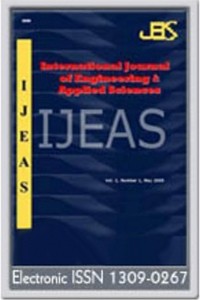The Complementary Functions Method Solution to the Functionally Graded Polar Orthotropic Rotating Hyperbolic Disks with Both Radially and Circumferentially Aligned Fibers
In the present study, efforts have been made to numerically evaluate elastic displacements and stresses in a convergent or divergent hyperbolic disk subjected to a centrifugal force of constant circular velocity. The disk material is assumed to be continuously radially functionally graded (FG) with two orthotropic materials based on the simplest Voigt rule with a power of volume fraction of two constituents. The fibers are assumed to be aligned along either radial (RR) or circumferential (CR) directions. Having been a second order differential equation with variable coefficients, the governing equation so-called Navier equation is first derived and then put in the form of two differential equations of first order. These two ordinary differential equation set is originally solved based on the initial value problem (IVP) by employing the Complementary Functions Method (CFM). The numerical results are verified with the corresponding benchmark results for uniform thickness FG polar orthotropic disks. The radial variation of the elastic fields in a hyperbolic disk is investigated for several boundary conditions, disk profile parameters, and the gradient parameter for both the radially and circumferentially aligned fibers. Some numerical results are also presented. Under the case that is considered in this study, it is revealed that the CR disk offers much higher elastic fields than RR disk under all boundary conditions. For a composite rotating disk rotating at a constant speed, it will be better to align fibers along the radial directions, to use convergent disk profiles, and to locate the material having higher radial stiffness at the outer surface. It is also disclosed that the location of the maximum Von-Mises equivalent stress in fixed-free disks varies regarding the fiber orientation.
Keywords:
Anisotropic, complementary functions method, composite rotating disk, elasticity solution, functionally graded, initial value problem, polar orthotropic variable-thickness,
___
- [1] Durodola, J., Attia, O., Deformation and stresses in functionally graded rotating discs”, Compos Sci Technol, 60, 987-995, 2000.
- [2] Chen, J., Ding, H., Chen, W., Three-dimensional analytical solution for a rotating disc of functionally graded materials with transverse isotropy, Archive of Applied Mechanics, 77, 241-251, 2007.
- [3] Kansal, G., Parvez, M., Thermal stress analysis of orthotropic graded rotating discs, International Journal of Modern Engineering Research (IJMER), 2(5), 3881-3885, 2012. [4] Lubarda, V. A., On pressurized curvilinearly orthotropic circular disc, cylinder and sphere made of radially nonuniform material, Journal of Elasticity, 109, 103-133, 2012.
- [5] Peng, X. L., Li, X. F., Elastic analysis of rotating functionally graded polar orthotropic discs, Int J Mech Sci, 60, 84-91, 2012.
- [6] Kacar, I., Yıldırım, V., Effect of the anisotropy ratios on the exact elastic behavior of functionally power-graded polar orthotropic rotating uniform discs under various boundary conditions, Digital Proceeding of ICOCEE – Cappadocia 2017, Nevsehir, Turkey, 1743-1752, 2017.
- [7] Essa, S., Argeso, H., Elastic analysis of variable profile and polar orthotropic FGM rotating disks for a variation function with three parameters, Acta Mech, 228, 3877–3899, 2017.
- [8] Zheng, Y., Bahaloo, H., Mousanezhad, D., Vaziri, A., Nayeb-Hashemi, H., Displacement and stress fields in a functionally graded fiber-reinforced rotating disk with nonuniform thickness and variable angular velocity, J Eng Mater Technol, ASME, 39, 031010-1-9, 2017.
- [9] Callioglu, H., Thermal stress analysis of curvilinearly orthotropic rotating discs, J Thermoplast Compos Mater, 20, 357-369, 2007.
- [10] Callioglu, H., Topcu, M., Altan, G., Stress analysis of curvilinearly orthotropic rotating discs under mechanical and thermal loading, J Reinf Plast Compos, 24, 831-838, 2005.
- [11] Tahani, M., Nosier, A., Zebarjad, S. M., Deformation and stress analysis of circumferentially fiber-reinforced composite disks, Int. J. Solids Struct, 42(9–10), 2741–2754, 2005.
- [12] Zenkour A.M.,Allam N.M.N., On the rotating fiber-reinforced viscoelastic composite solid and annular disks of variable thickness, Int. J. Comput. Methods Eng. Sci Mech., 7, 21-31, 2006.
- [13] Aktas, Z., Numerical Solutions of Two-Point Boundary Value Problems. Ankara, Turkey, METU, 1972.
- [14] Roberts, S., Shipman, J., Fundamental matrix and two-point boundary-value problems, Journal of Optimization Theory and Applications, 28(1), 77-88, 1979.
- [15] Haktanır, V., The complementary functions method for the element stiffness matrix of arbitrary spatial bars of helicoidal axes, Int J Numer Meth Eng, 38(6), 1031–1056, 1995.
- [16] Yıldırım, V., Free vibration analysis of non-cylindrical coil springs by combined use of the transfer matrix and the complementary functions methods, Comm Numer Meth Eng, 13(6), 487–94, 1997.
- [17] Yıldırım, V., The complementary functions method (CFM) solution to the elastic analysis of polar orthotropic rotating discs, J. Appl. Comput. Mech, 4(3), 216-230, 2018. DOI: 10.22055/JACM.2017.23188.1150
- [18] Callioglu, H., Stress analysis of an orthotropic rotating disc under thermal loading, J Reinf Plast Compos, 23(17), 1857–1869, 2004.
- Başlangıç: 2009
- Yayıncı: Akdeniz Üniversitesi
